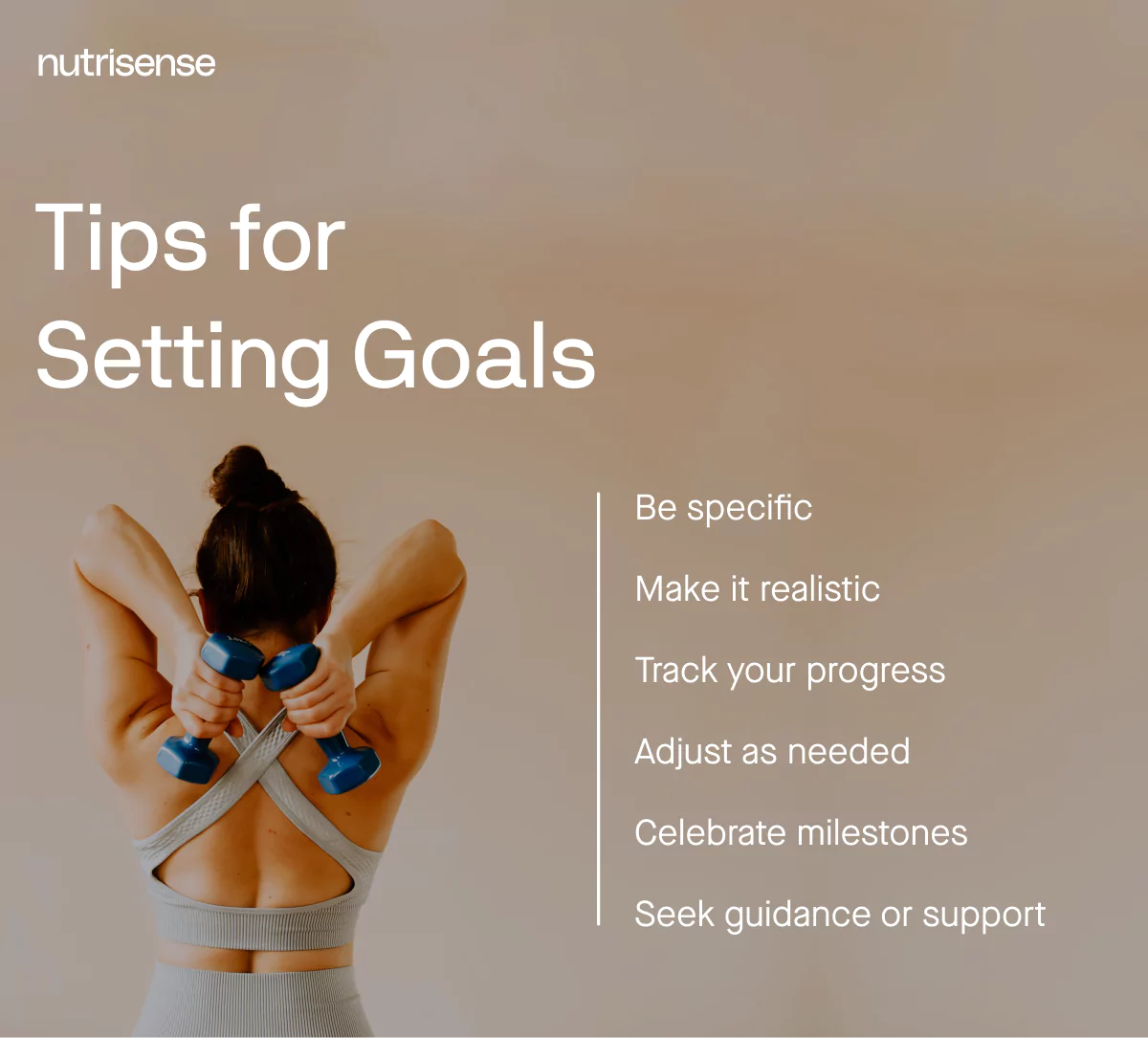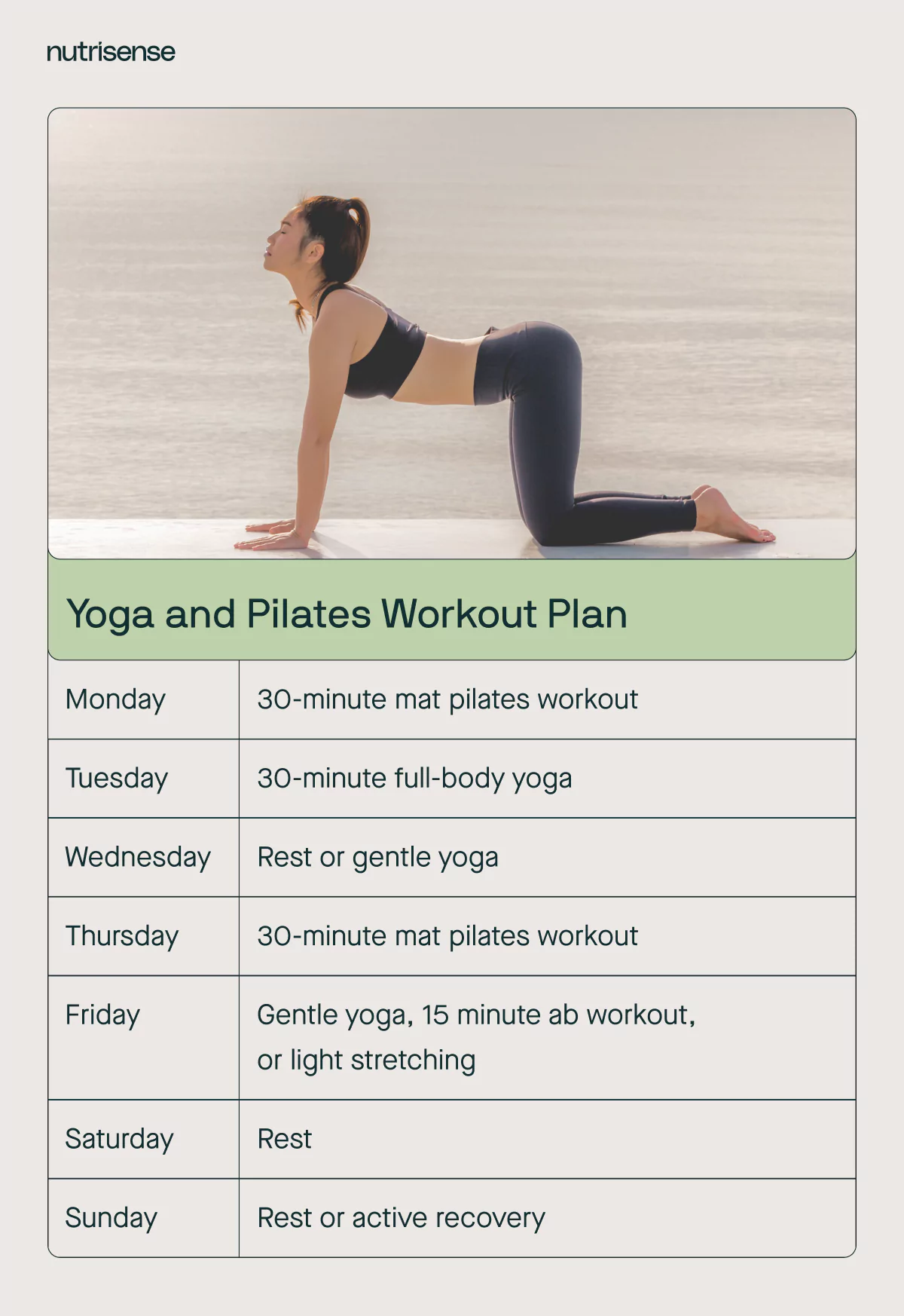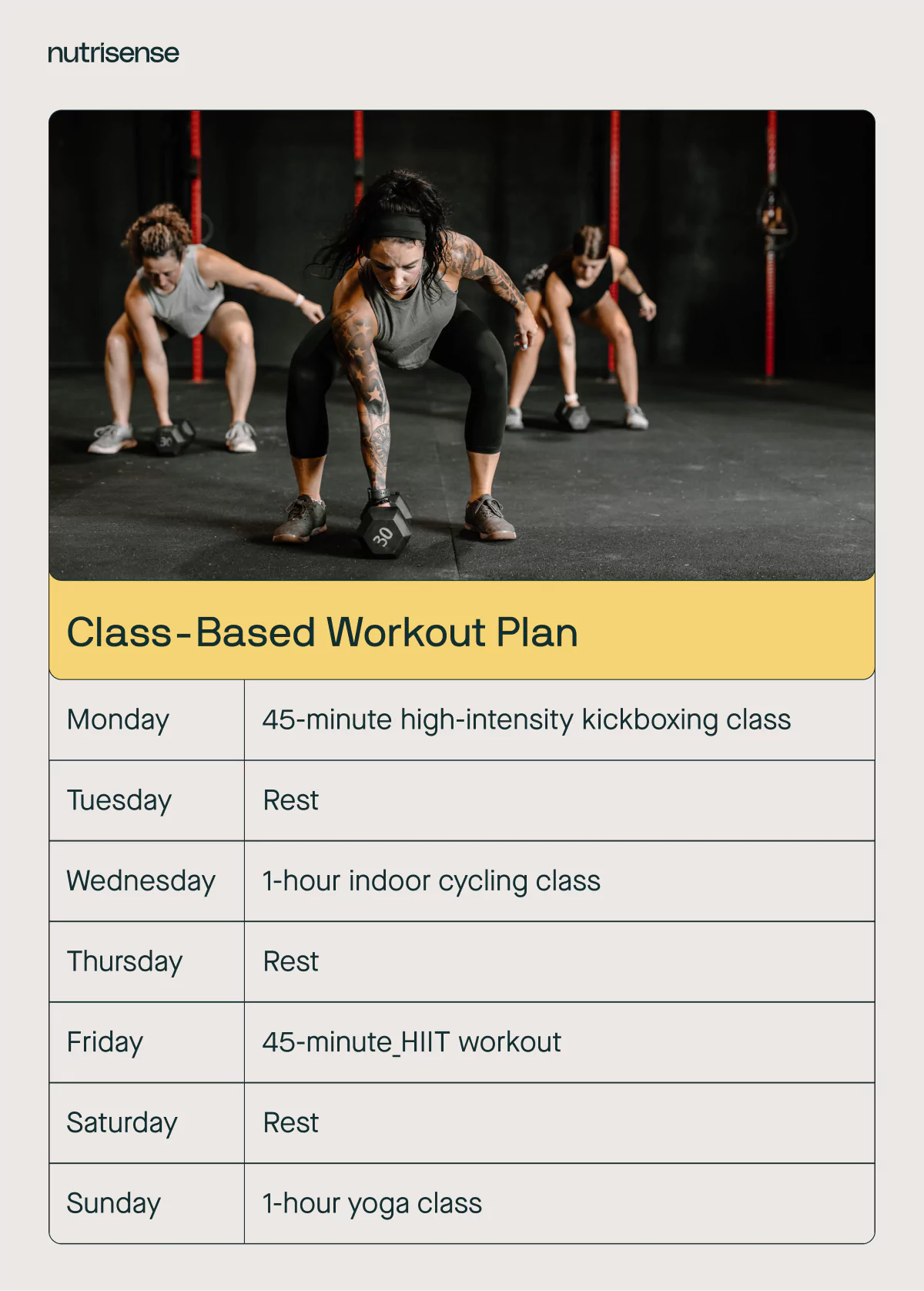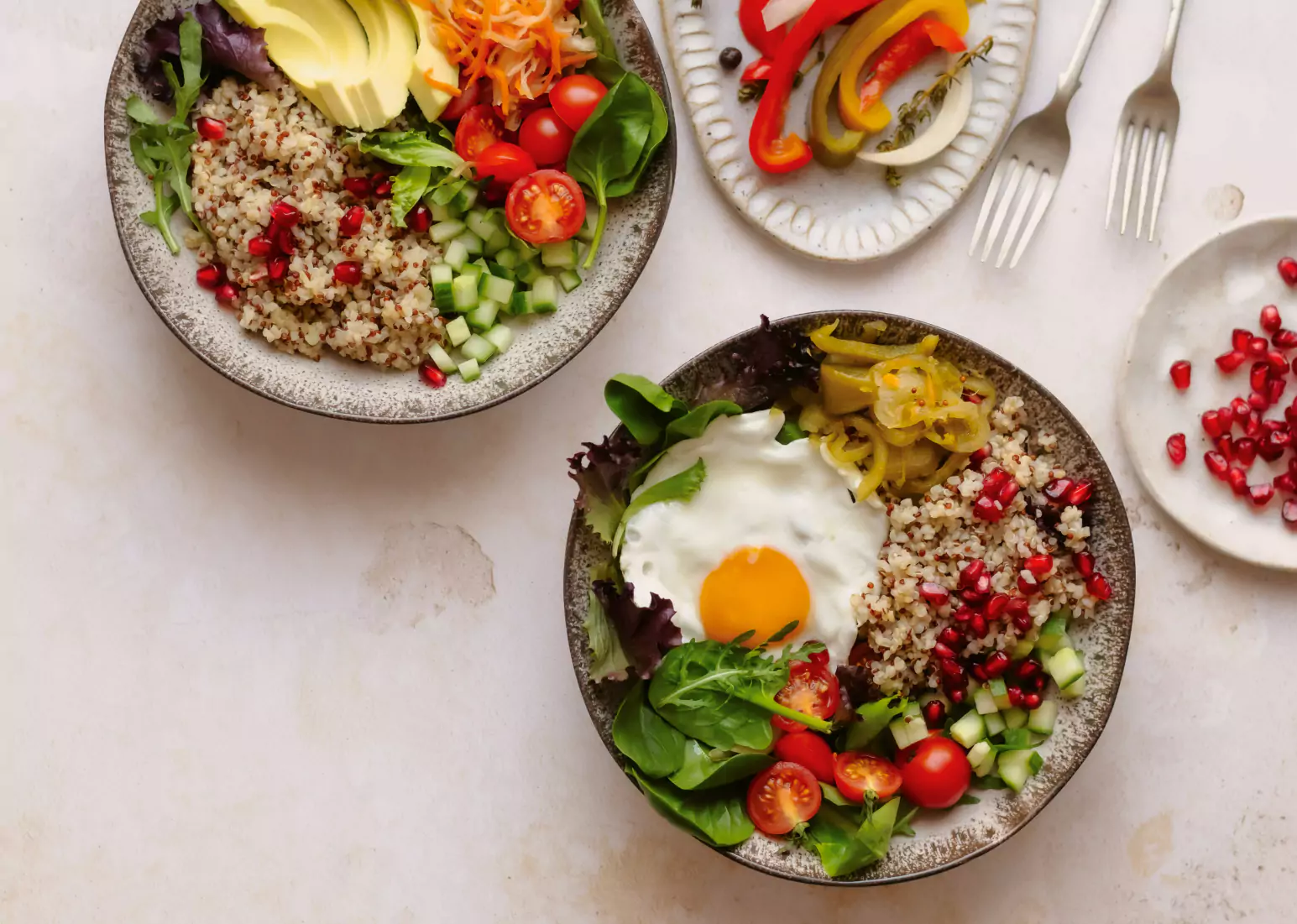Best Workout Plans for Women [Sample Training Plans Included]

Key Takeways
Whether you're seeking to build muscle, boost cardiovascular endurance, or simply enhance your overall well-being, embarking on a fitness journey is a powerful and transformative endeavor.
But for some women just starting out, it can be hard to find the right workout routine for your goals and lifestyle. In this article, we'll share a few weekly workout plans that are tailored to suit the unique needs and goals of women.
Whether you're a beginner looking to kickstart your fitness routine or an experienced enthusiast aiming to achieve new milestones, we've got you covered! Keep reading for your new workout plan.
Understanding Your Fitness Level and Setting Goals

Self-assessing your fitness level is an important starting point on your fitness journey. It can help you understand what your abilities are and provide a baseline to track your progress. Here's are some tips for self-assessing your fitness level:
- Cardiovascular Fitness: Gauge your cardiovascular endurance by performing activities like walking, jogging, or cycling and noting the time it takes you to complete a set distance or the duration you can sustain the activity before feeling fatigued. You can also monitor your heart rate during a cardio workout using a heart rate monitor or fitness tracker.
- Muscular Strength and Endurance: Evaluate your muscular strength with exercises like push-ups, squats, shoulder presses, and bicep curls. Record how many repetitions you can perform with proper form.
- Flexibility: Measure your flexibility by attempting stretches that target major muscle groups. Pay attention to the range of motion and any discomfort you might feel. Common flexibility tests include the sit-and-reach test and shoulder flexibility assessments.
- Functional Movement: Assess functional movements like squats, lunges, and balance exercises to evaluate your overall movement quality. Identify any limitations, weaknesses, or imbalances that might need attention.
Tips for Setting Achievable Goals

Once you've assessed your fitness level, it's time to set goals that are both realistic and achievable. Here's how to approach goal-setting:
- Be Specific: Clearly define your goals. Vague goals like "get in shape" are harder to work towards. Instead, aim for specific achievements like completing a five kilometer run or doing 10 consecutive push-ups.
- Make It Realistic: While ambition is important, set goals that are within your reach. Unrealistic goals can lead to frustration and disappointment. Whether your goal is weight loss or muscle building, make sure you set an achievable target when starting out.
- Track Progress: Keep a record of your workouts, achievements, and any setbacks. This documentation can be motivating and provides insights into your progress.
- Adjust as Needed: Life is always changing. Be willing to adapt your goals if necessary, without feeling discouraged.
- Celebrate Milestones: When you reach a milestone, celebrate it! Recognize your hard work and dedication with a small reward or by treating yourself to something special.
- Seek Guidance: If needed, consult a fitness professional to help you set appropriate goals based on your fitness level, health considerations, and aspirations.
3 Sample Workout Plans to Try Today
With an understanding of your current fitness level and well-defined goals in place, you're equipped for the next phase of your fitness journey. In this section, we’ll detail three full body workout plans that will guide you towards achieving your fitness objectives.
Check these out and choose the workout regimen that resonates best with your goals and lifestyle:
1) Muscle and Strength Workout Schedule

A full-body strength workout for women focuses on building lean muscle mass and enhancing overall strength. Strength training can be immensely beneficial for women, positively affecting glucose balance, weight management, and bone health.
Keep in mind that rest days are important in all workout plans, and you should break them up in a way that works for you. When it comes to your workouts, always remember to warm up and cool down, listen to your body, and adjust the workout intensity or exercises to prevent overtraining or injuries.
- Monday (Lower Body): Focus on exercises that target your glutes and hamstrings, like squats, deadlifts, lunges, hip thrusts, leg extensions, and glute bridges.
- Tuesday (Upper Body): Focus on exercises that target your back and arms, like pull-ups, rows, lat pulldowns, bicep curls, tricep dips, dumbbell row, and push-ups. Incorporate moderate-intensity cardio, like running, cycling, or swimming.
- Wednesday: Rest
- Thursday (Lower Body): Focus on exercises that target the quads and glutes, like step-ups, lunges, front squats, or box jumps.
- Friday (Upper Body): Try exercises that target the chest and shoulders, like bench presses, chest presses, push-ups, lateral raises, upright rows, or front raises.
- Saturday (Cardio): Mix it up with 30-40 minutes of moderate-intensity or steady-state cardio, like running, cycling, or swimming.
- Sunday: Rest
2) Yoga and Pilates Workout Plan

Yoga and pilates offer a holistic approach to fitness, emphasizing flexibility, balance, core strength, and a strong mind-body connection. These practices are not only physically beneficial but also contribute to stress reduction and mental well-being.
Yoga focuses on flowing sequences and static poses, promoting flexibility and relaxation. Pilates, on the other hand, emphasizes controlled movements that strengthen the core and enhance overall body stability.
- Monday: 30-minute mat pilates workout
- Tuesday: 30-minute full-body yoga for flexibility and strength
- Wednesday: Rest or gentle yoga
- Thursday: 30-minute mat pilates workout
- Friday: Gentle yoga, 15 minute ab workout, or light stretching
- Saturday: Rest
- Sunday: Rest or active recovery
3) Class-Based Workout Plan

Utilizing fitness classes as part of your workout program can add variety, structure, and motivation to your fitness journey. Gym workout classes like kickboxing, spin, and other group workouts offer a dynamic and engaging way to achieve your fitness goals while enjoying a supportive and energetic environment.
- Monday: Try a 45-minute high-intensity kickboxing class. Focus on cardio, kick combinations, and bodyweight exercises, and cool down with stretches and deep breathing.
- Tuesday: Rest
- Wednesday: Try an hour long indoor cycling class that incorporates intervals of high-intensity cycling and recovery periods
- Thursday: Rest
- Friday: Take a 45-minute high-intensity interval training or HIIT workout that combines cardio, strength exercises, and plyometrics.
- Saturday: Rest
- Sunday: One hour yoga class for flexibility and core strength.
Importance of Customized Workout Plans for Women

While there are undeniable similarities between male and female bodies, women do have distinct physical and physiological characteristics that can underscore the importance of customized workout plans. Addressing women’s unique needs can help foster engaging and diverse workout routines that can help women stay committed, reduce the risk of injury, and lead to sustainable results.
Here are a few distinctions that can affect women specifically.
Higher Body Fat Levels
Women tend to have a higher proportion of body fat and a lower proportion of muscle mass than men. Recognizing and accommodating these unique physical characteristics is important for achieving optimal fitness results.
Hormonal Fluctuations
Another primary example is hormonal fluctuations: the menstrual cycle, pregnancy, and menopause introduce variations in hormone levels that can impact energy levels and recovery in women. Tailored workout plans should take these fluctuations into account, optimizing training timing and intensity to align with the body's natural rhythm.
Changes In Bone Density
Bone health is another concern that can impact women at higher rates. Women undergo significant changes in bone density throughout their life, making it crucial to incorporate specific exercises that enhance bone strength. Tailored workout plans should emphasize weight lifting, resistance training, and impact activities to reduce the risk of osteoporosis and fractures.
Nutrition and Hydration Tips for Optimal Fitness Results

Nutrition and hydration are pillars of any effective workout plan. They provide the essential fuel and support your body needs to perform, recover efficiently, and achieve your fitness goals. Without proper attention to nutrition and hydration, your efforts in the gym or during workouts may not give you the desired results. Here's why they are crucial:
Energy for Optimal Performance
Your body requires energy to power through workouts and your diet is the primary source of this energy. Carbohydrates, especially complex carbs, provide sustained energy, while protein aids in muscle repair and growth. Adequate intake of these macronutrients, including healthy fats, ensures that you have the energy to perform at your best and push through challenging workouts.
Unfortunately, research shows that female athletes often don’t fuel their bodies properly. When people don’t eat enough to support both their basic bodily functions and their workout, it’s called low energy availability, or LEA. Studies have shown that high percentages of female athletes, including synchronized swimmers, soccer players, and cross-country runners are at risk for LEA.
Recovery and Muscle Growth
Proper nutrition plays a pivotal role in recovery after exercise. Protein is essential for repairing and building muscle tissues that are broken down during workouts. A balanced diet that includes lean proteins, whole grains, healthy fats, and a variety of fruits and vegetables provides the necessary nutrients for muscle recovery and growth.
Hydration and Performance

Dehydration can lead to decreased performance, early fatigue, and impaired concentration. During workouts, you lose fluids through sweat, and it's crucial to replace these lost fluids and consume adequate amounts of electrolytes to maintain optimal performance. Staying hydrated helps regulate body temperature and ensures that your muscles and joints function smoothly.
Mental Focus and Mood
Nutrition doesn't only affect your physical well-being; it also influences your mental state. Nutrient-rich foods can boost mood, mental clarity, and focus, enhancing your overall workout experience.
All in all, incorporating balanced meals, proper hydration, and mindful nutrient choices into your routine supports your workout efforts and promotes overall well-being. Consulting a registered dietitian or nutritionist can provide personalized guidance tailored to your fitness goals and individual needs.
Remember, your body's performance is a reflection of what you fuel it with, so prioritize your nutrition and hydration to make the most of your workout plans.
Find the right Nutrisense programto turn insight into progress.
Go Beyond Glucose Data with Nutrisense
Your glucose can significantly impact how your body feels and functions. That’s why stable levels are an important factor in supporting overall wellbeing. But viewing glucose isn't enough. Nutrisense, you’ll be able to learn how to use your body's data to make informed lifestyle choices that support healthy living.
One-to-one coaching
Sign up to access insurance-covered video calls to work with a glucose expert: a personal registered dietitian or certified nutritionist who will help tailor your lifestyle and diet to your goals.
Monitor and measure what matters
With the Nutrisense CGM Program, you can monitor your glucose with health tech like glucose biosensors and continuous glucose monitor (CGM)s, and analyze the trends over time with the Nutrisense App. This will help you make the most informed choices about the foods you consume and their impact on your health.
Find your best fit
Ready to take the first step? Start with our quiz to find the right Nutrisense program to help you take control.

Heather is a Registered and Licensed Dietitian Nutritionist (RDN, LDN), subject matter expert, and technical writer, with a master's degree in nutrition science from Bastyr University. She has a specialty in neuroendocrinology and has been working in the field of nutrition—including nutrition research, education, medical writing, and clinical integrative and functional nutrition—for over 15 years.




